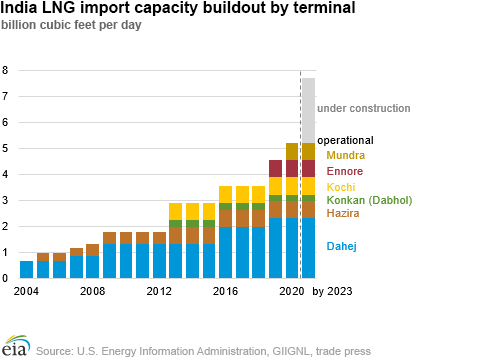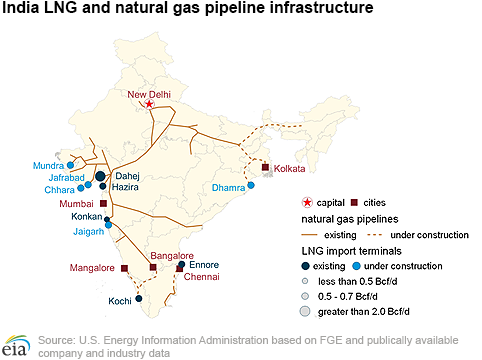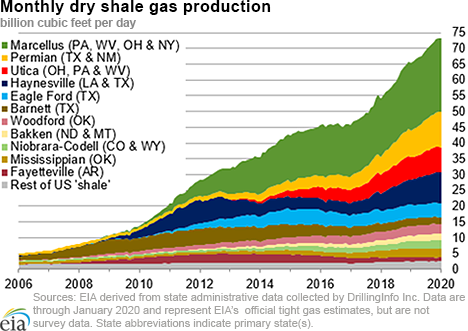In the News:
India’s sixth LNG import terminal comes online
In January 2020 India commissioned its sixth liquefied natural gas (LNG) import terminal, Mundra LNG, with a nominal import capacity of 0.7 billion cubic feet per day (Bcf/d). Mundra LNG is the third LNG import terminal located in India’s westernmost state, close to major natural gas consumption centers and a well-developed pipeline network.
All LNG import terminals in India except one are located on the west coast along the Arabian Sea. The first two terminals in operation—Dahej (2.3 Bcf/d capacity) and Hazira (0.7 Bcf/d capacity)—were placed in service in 2004 and 2005, respectively. These two terminals are the most utilized LNG facilities in India, operating at nearly 100% capacity utilization. In 2013, the Konkan terminal (formerly called Dabhol LNG, 0.3 Bcf/d capacity), located south of Mumbai, and Kochi LNG (0.7 Bcf/d), located adjacent to the Kochi refinery in southern India, were placed in service. Last year, India commissioned its first terminal on the southeast coast—Ennore LNG (0.7 Bcf/d)—primarily to serve customers in the Chennai area.
In the next three years, India’s LNG import capacity is expected to increase by one-third, with four terminals under construction expected to come online by 2023:
- Jaigarh LNG Floating Storage and Regasification Unit (FSRU) (0.5 Bcf/d capacity)
- Dhamra LNG (0.7 Bcf/d)
- Jafrabad FSRU (0.7 Bcf/d)
- Chhara LNG (0.7 Bcf/d)
Western India—the location of the Dahej, Hazira, and Mundra terminals—has a highly developed natural gas infrastructure, but the southern and eastern regions of the country lack pipelines to move natural gas from coastal LNG import terminals to major demand centers further inland. Future growth in India's LNG imports will be contingent on the timely completion of connecting pipelines. There has been limited pipeline development to move natural gas to cities north and northeast of the Kochi terminal, affecting its utilization. In addition, the pipelines connecting the Ennore LNG terminal to cities to the north and south of Chennai still need to secure land permits before construction can begin. In the meantime, the Ennore terminal supplies a local refinery and city-gas customers in Chennai.
Overview:
(For the week ending Wednesday, February 26, 2019)
- Natural gas spot prices fell at most locations this report week (Wednesday, February 19 to Wednesday, February 26). The Henry Hub spot price fell from $2.02 per million British thermal units (MMBtu) last Wednesday to $1.92/MMBtu yesterday.
- At the New York Mercantile Exchange (Nymex), the March 2020 contract expired yesterday at $1.821/MMBtu, down 13¢/MMBtu from last Wednesday. The April 2020 contract price decreased to $1.837/MMBtu, down 13¢/MMBtu from last Wednesday to yesterday. The price of the 12-month strip averaging April 2020 through March 2021 futures contracts declined 8¢/MMBtu to $2.171/MMBtu.
- The net withdrawal from working gas totaled 143 billion cubic feet (Bcf) for the week ending February 21. Working natural gas stocks total 2,200 Bcf, which is 41% more than the year-ago level and 9% more than the five-year (2015–19) average for this week.
- The natural gas plant liquids composite price at Mont Belvieu, Texas, rose by 9¢/MMBtu, averaging $4.64/MMBtu for the week ending February 26. The prices of natural gasoline and butane fell by 4% and 1%, respectively. The prices of propane and isobutane rose by 8% and 4%, respectively. The price of ethane remained flat week over week.
- According to Baker Hughes, for the week ending Tuesday, February 18, the natural gas rig count remained flat at 110. The number of oil-directed rigs rose by 1 to 679. The total rig count increased by 1, and it now stands at 791.
Prices/Supply/Demand:
Notice: EIA revised the paragraph on U.S. LNG exports to reflect corrected information from Bloomberg.
Prices fall across the Lower 48 states. This report week (Wednesday, February 19 to Wednesday, February 26), the Henry Hub spot price fell 10¢ from a high of $2.02/MMBtu last Wednesday to $1.92/MMBtu yesterday, after reaching a low of $1.89/MMBtu on Monday. Temperatures were generally close to normal across most of the country and warmer than normal in the Northeast and upper Midwest. At the Chicago Citygate, the price decreased 14¢ from a high of $1.90/MMBtu last Wednesday to $1.76/MMBtu yesterday. The price at PG&E Citygate in Northern California fell 3¢, down from a high of $2.68/MMBtu last Wednesday to $2.65/MMBtu yesterday. The price at SoCal Citygate in Southern California decreased 19¢ from a high of $2.39/MMBtu last Wednesday to $2.20/MMBtu yesterday.
Northeast prices fall. At the Algonquin Citygate, which serves Boston-area consumers, the price went down 67¢ from a high of $2.78/MMBtu last Wednesday to $2.11/MMBtu yesterday. At the Transcontinental Pipeline Zone 6 trading point for New York City, the price decreased 43¢ from a high of $2.33/MMBtu last Wednesday to $1.90/MMBtu yesterday.
The Tennessee Zone 4 Marcellus spot price decreased 20¢ from $1.80/MMBtu last Wednesday to $1.60/MMBtu yesterday. The price at Dominion South in southwest Pennsylvania fell 14¢ from $1.79/MMBtu last Wednesday to $1.65/MMBtu yesterday.
Pipeline compressor issue puts downward pressure on Permian Basin prices. The Natural Gas Pipeline Company of America (NGPL) declared a force majeure on February 26 because of a compressor station failure in Ford County, Kansas, 150 miles west of Wichita. The force majeure is in effect until March 3 and could curtail 73% of flows on the Amarillo Mainline, according to Genscape. The Amarillo Mainline in the NGPL system delivers natural gas from producers in Texas and Oklahoma into the Market Zone in the Midwest. The price at the Waha Hub in West Texas, which is located near Permian Basin production activities, averaged a high of $0.56/MMBtu last Wednesday, $1.46/MMBtu lower than the Henry Hub price. Yesterday, the price at the Waha Hub averaged $0.36/MMBtu, $1.56/MMBtu lower than the Henry Hub price. The Waha Hub price reached a low of $0.14/MMBtu on Thursday.
Supply is flat. According to data from IHS Markit, the average total supply of natural gas remained the same as in the previous report week, averaging 100.0 Bcf/d. Dry natural gas production remained unchanged week over week. Average net imports from Canada decreased by 7% from last week amid lower demand in Northeast and Midwestern markets.
Demand falls with warm temperatures in key demand centers. Total U.S. consumption of natural gas fell by 4% compared with the previous report week, according to data from IHS Markit. Natural gas consumed for power generation declined by 3% week over week. Industrial sector consumption increased by 2% week over week. In the residential and commercial sectors, consumption declined by 8%. Natural gas exports to Mexico were the same as last week, averaging 5.4 Bcf/d.
U.S. LNG exports increase week over week. Eighteen LNG vessels (eight from Sabine Pass, four from Corpus Christi, three from Freeport, two from Cameron, and one from Cove Point) with a combined LNG-carrying capacity of 66 Bcf departed the United States between February 20 and February 26, 2020, according to shipping data compiled by Bloomberg. One vessel was loading at the Corpus Christi terminal on Wednesday.
Storage:
The net withdrawal from storage totaled 143 Bcf for the week ending February 21, compared with the five-year (2015–19) average net withdrawal of 122 Bcf and last year's net withdrawal of 167 Bcf during the same week. Working natural gas stocks totaled 2,200 Bcf, which is 179 Bcf more than the five-year average and 637 Bcf more than last year at this time.
According to The Desk survey of natural gas analysts, estimates of the weekly net change to working natural gas stocks ranged from a net withdrawal of 140 Bcf to 167 Bcf, with a median estimate of 157 Bcf.
The average rate of withdrawal from storage is 9% lower than the five-year average so far in the withdrawal season (November through March). If the rate of withdrawal from storage matched the five-year average of 8.3 Bcf/d for the remainder of the withdrawal season, the total inventory would be 1,876 Bcf on March 31, which is 179 Bcf higher than the five-year average of 1,697 Bcf for that time of year.
More storage data and analysis can be found on the Natural Gas Storage Dashboard and the Weekly Natural Gas Storage Report.
See also:
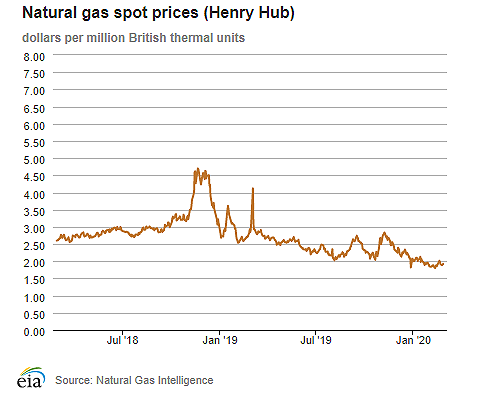
| Spot Prices ($/MMBtu) | Thu, 20-Feb |
Fri, 21-Feb |
Mon, 24-Feb |
Tue, 25-Feb |
Wed, 26-Feb |
|---|---|---|---|---|---|
| Henry Hub |
1.98 |
1.92 |
1.89 |
1.90 |
1.92 |
| New York |
2.24 |
1.90 |
1.68 |
1.76 |
1.90 |
| Chicago |
1.84 |
1.75 |
1.73 |
1.77 |
1.76 |
| Cal. Comp. Avg.* |
2.13 |
2.07 |
2.04 |
2.06 |
2.08 |
| Futures ($/MMBtu) | |||||
| March contract | 1.920 |
1.905 |
1.827 |
1.847 |
1.821 |
| April contract |
1.931 |
1.917 |
1.843 |
1.851 |
1.837 |
| *Avg. of NGI's reported prices for: Malin, PG&E Citygate, and Southern California Border Avg. | |||||
| Source: NGI's Daily Gas Price Index | |||||
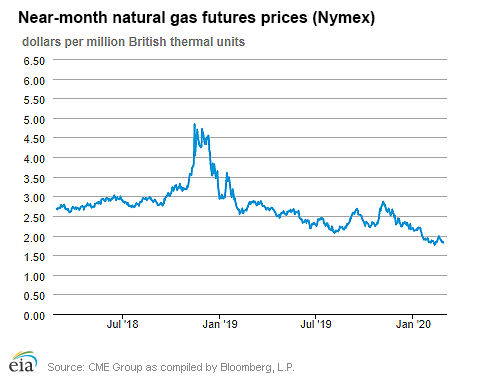
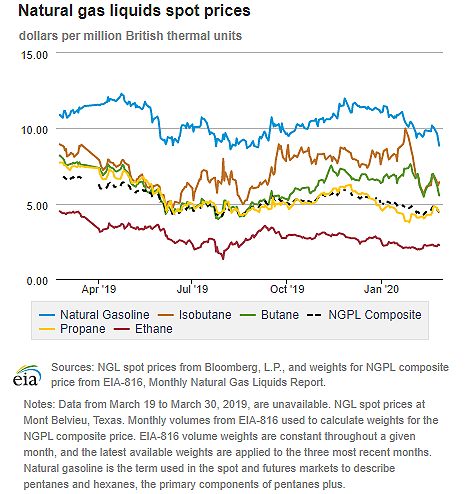
| U.S. natural gas supply - Gas Week: (2/20/20 - 2/26/20) | |||
|---|---|---|---|
Average daily values (Bcf/d): |
|||
this week |
last week |
last year |
|
| Marketed production | 107.1 |
107.1 |
100.2 |
| Dry production | 94.7 |
94.7 |
89.2 |
| Net Canada imports | 5.1 |
5.4 |
4.8 |
| LNG pipeline deliveries | 0.2 |
0.2 |
0.3 |
| Total supply | 100.0 |
100.3 |
94.2 |
|
Source: IHS Markit | |||
| U.S. natural gas consumption - Gas Week: (2/20/20 - 2/26/20) | |||
|---|---|---|---|
Average daily values (Bcf/d): |
|||
this week |
last week |
last year |
|
| U.S. consumption | 95.5 |
99.7 |
100.0 |
| Power | 28.3 |
29.1 |
28.7 |
| Industrial | 24.9 |
24.5 |
26.3 |
| Residential/commercial | 42.3 |
46.1 |
45.1 |
| Mexico exports | 5.4 |
5.4 |
4.8 |
| Pipeline fuel use/losses | 7.4 |
7.5 |
7.2 |
| LNG pipeline receipts | 8.7 |
8.0 |
5.1 |
| Total demand | 117.0 |
120.5 |
117.1 |
|
Source: IHS Markit | |||
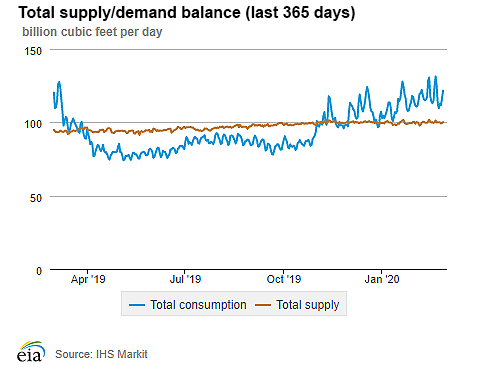
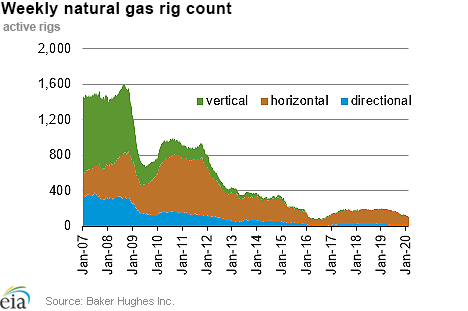
| Rigs | |||
|---|---|---|---|
Tue, February 18, 2020 |
Change from |
||
last week |
last year |
||
| Oil rigs | 679 |
0.1% |
-20.4% |
| Natural gas rigs | 110 |
0.0% |
-43.3% |
| Note: Excludes any miscellaneous rigs | |||
| Rig numbers by type | |||
|---|---|---|---|
Tue, February 18, 2020 |
Change from |
||
last week |
last year |
||
| Vertical | 32 |
6.7% |
-49.2% |
| Horizontal | 714 |
0.1% |
-22.1% |
| Directional | 45 |
-4.3% |
-33.8% |
| Source: Baker Hughes Inc. | |||
| Working gas in underground storage | ||||
|---|---|---|---|---|
Stocks billion cubic feet (Bcf) |
||||
| Region | 2020-02-21 |
2020-02-14 |
change |
|
| East | 484 |
527 |
-43 |
|
| Midwest | 591 |
639 |
-48 |
|
| Mountain | 108 |
117 |
-9 |
|
| Pacific | 196 |
198 |
-2 |
|
| South Central | 821 |
861 |
-40 |
|
| Total | 2,200 |
2,343 |
-143 |
|
|
Source: Form EIA-912, Weekly Underground Natural Gas Storage Report | ||||
| Working gas in underground storage | |||||
|---|---|---|---|---|---|
Historical comparisons |
|||||
Year ago (2/21/19) |
5-year average (2015-2019) |
||||
| Region | Stocks (Bcf) |
% change |
Stocks (Bcf) |
% change |
|
| East | 360 |
34.4 |
415 |
16.6 |
|
| Midwest | 392 |
50.8 |
494 |
19.6 |
|
| Mountain | 80 |
35.0 |
121 |
-10.7 |
|
| Pacific | 124 |
58.1 |
211 |
-7.1 |
|
| South Central | 605 |
35.7 |
779 |
5.4 |
|
| Total | 1,563 |
40.8 |
2,021 |
8.9 |
|
| Source: Form EIA-912, Weekly Underground Natural Gas Storage Report | |||||
| Temperature – heating & cooling degree days (week ending Feb 20) | ||||||||
|---|---|---|---|---|---|---|---|---|
HDD deviation from: |
CDD deviation from: |
|||||||
| Region | HDD Current |
normal |
last year |
CDD Current |
normal |
last year |
||
| New England | 254 |
-2 |
2 |
0 |
0 |
0 |
||
| Middle Atlantic | 239 |
-4 |
5 |
0 |
0 |
0 |
||
| E N Central | 285 |
24 |
9 |
0 |
0 |
0 |
||
| W N Central | 299 |
34 |
-36 |
0 |
0 |
0 |
||
| South Atlantic | 146 |
-11 |
8 |
17 |
9 |
2 |
||
| E S Central | 148 |
-5 |
13 |
0 |
-1 |
0 |
||
| W S Central | 96 |
-8 |
-10 |
6 |
2 |
2 |
||
| Mountain | 208 |
10 |
-31 |
0 |
-1 |
0 |
||
| Pacific | 96 |
-5 |
-57 |
0 |
0 |
0 |
||
| United States | 201 |
6 |
-12 |
4 |
2 |
1 |
||
|
Note: HDD = heating degree day; CDD = cooling degree day Source: National Oceanic and Atmospheric Administration | ||||||||
Average temperature (°F)
7-day mean ending Feb 20, 2020
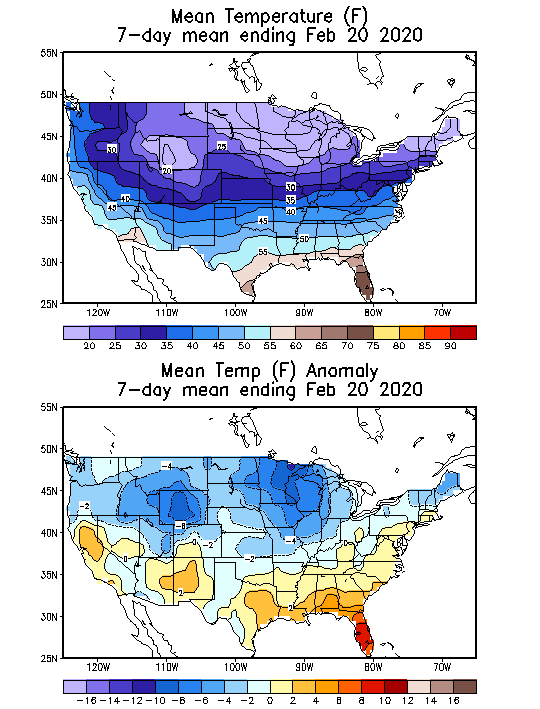
Source: National Oceanic and Atmospheric Administration
Deviation between average and normal (°F)
7-day mean ending Feb 20, 2020

Source: National Oceanic and Atmospheric Administration

